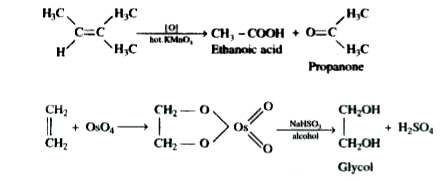Oxidation of alkenes by cleavage with acidic or alkaline KMnO4 or acidic K2Cr2O7 at higher temperature yields products depending upon the nature of alkene. A hot solution of is a strong oxidizing agent which gives only ketones and carboxylic acids and not aldehydes (as they cannot be isolated)

Which of the these compounds on treatment with OsO4 followed by Na2SO3 will give Cis-2-methyl butane-2,3-diol? Solution in Telugu
2-Methyl-2-butene
4-methyl-2-pentene
2,3-Dimethyl-2-butene
2,2-Dimethyl-2-butene
The correct Answer is:A
2-Methyl-2-butene
Similar Questions
Lemieux reagent consist of an aqueous solution of sodium periodate (NaIO4) and a trace of KMnO4 It is used for locating the position of double bond in an alkene. During the reaction, the alkene is first oxidised to cis-diol which upon cleavage with sodium peroxide gives aldehydes and ketones (similar to ozonolysis). Hot solution of acidic or alkaline KMnO4 can also be used for locating double bond by observing the products which are ketones or carboxylic acids. Position of triple bond can be identified by similar process.
An alkene on treatment with NaIO4,KMnO4andNa2O2 gives acetone and acetaldehyde. The alkene is :
View SolutionAlkenes can be oxidized in presence of different reagents to give different products. Alkenes on oxidation in presence of silver at high temperature give cyclic ethers, which also can be synthesized by using per acids. Alkenes on reductive ozonolysis give carbonyl compounds in presence of zinc and peroxide. On reaction with acidic KMnO4, it also produces corresponding carbonyl compound. Alkynes can also be oxidized in presence of such reagents but the products are different.
A hydrocarbon (C8H16) on oxidation with a hot acidified solution of KMnO4 forms 2-buanone and isobutyric acid. The hydrocarbon is
View SolutionAlkenes undergo a variety of oxidation reactions. With cold and neutral or alkaline KMnO4, alkenes are oxidised to give vicinal diols. Oxidation with hot KMnO4 undergoes cleavage of C=C bond leading to the formation of carboxylic acids, ketones and carbon dioxide depending on the nature ofalkene. Reductive ozonolysis of alkenes give aldehydes or ketones.
But-2-ene on treatment with cold alk. KMnO4 gives
View SolutionAlkenes undergo a variety of oxidation reactions. With cold and neutral or alkaline KMnO_(4) , alkenes are oxidised to give vicinal diols. Oxidation with hot KMnO_(4) undergoes cleavage of C=C bond leading to the formation of carboxylic acids, ketones and carbon dioxide depending on the nature ofalkene. Reductive ozonolysis of alkenes give aldehydes or ketones. An alkene 'X' on treatment with hot alkaline KMnO_(4) gives acetic acid. Alkene X' is
View SolutionAlkenes undergo a variety of oxidation reactions. With cold and neutral or alkaline KMnO_(4) , alkenes are oxidised to give vicinal diols. Oxidation with hot KMnO_(4) undergoes cleavage of C=C bond leading to the formation of carboxylic acids, ketones and carbon dioxide depending on the nature ofalkene. Reductive ozonolysis of alkenes give aldehydes or ketones. Reductive ozonolysis of alkene 'A' gives propanone. The alkene 'A' is
View SolutionAlkenes undergo a variety of oxidation reactions. With cold and neutral or alkaline KMnO_(4) , alkenes are oxidised to give vicinal diols. Oxidation with hot KMnO_(4) undergoes cleavage of C=C bond leading to the formation of carboxylic acids, ketones and carbon dioxide depending on the nature ofalkene. Reductive ozonolysis of alkenes give aldehydes or ketones. 2-Methyl propene on treatment with hot alkaline KMnO_(4) gives
View SolutionOxidation of alkenes by cleavage with acidic or alkaline KMnO_4 or acidic K_2Cr_2O_7 at higher temperature yields products depending upon the nature of alkene. A hot solution of is a strong oxidizing agent which gives only ketones and carboxylic acids and not aldehydes (as they cannot be isolated) Which of these compounds on oxidation with hot KMnOą gives only butanoic acid?
View Solution
